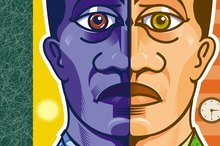Physiological Barriers to Communication
A physiological barrier to communication is the result of a sensory dysfunction, either on the part of the receiver or the sender. Speaking, hearing and seeing are fundamental parts of effective communication. For a person who is not able to speak, hear or see, certain measures must be taken to provide alternative communication options and methods and ensure communication is possible.
Hearing Impairment
One physiological barrier to communication is a hearing impairment. Hearing disorders can result from hereditary or genetic issues, developmental abnormalities, medical conditions such as infections, or other environmental or traumatic factors. While hearing loss typically will not cause a mental developmental problem, other areas such as speech and language, social development and educational achievement are affected by the condition 1. All of these areas rely heavily on a person’s ability to communicate with others. Auditory impairments not only delay an individual’s communication skills, but also decreases the amount of effective communication possible with other people.
- One physiological barrier to communication is a hearing impairment.
- Auditory impairments not only delay an individual’s communication skills, but also decreases the amount of effective communication possible with other people.
Speech Disorders
Examples of Speech Goals for Traumatic Brain Injuries
Learn More
Speech disorders are a common physiological barrier to communication. This includes different types of disorders such as stuttering, apraxia and dysarthria. Stuttering hinders the fluency of communication with prolonged speech sounds and repetitions of parts of words or entire words.
Apraxia of speech is a condition which occurs due to damage to the speaking part of the brain. This condition results in a person losing the ability to form syllables and words with sounds. The severity of the condition depends on the severity of the brain damage.
Another motor speech disorder is dysarthria, a condition in which the muscles of the face, mouth and respiratory system are weak and not able to work at full capacity. This condition may be caused by injuries and disorders such as muscular dystrophy, a stroke, a head injury or cerebral palsy. For a person unable to speak in an understandable and clear manner, communication will quickly break down.
- Speech disorders are a common physiological barrier to communication.
- This condition results in a person losing the ability to form syllables and words with sounds.
Vision Impairment
Vision impairment is also a physiological barrier to communication. The level of impairment is different for every individual. Loss of vision may not result in total blindness, but in difficulty noticing details, tunnel vision, blind spots, blurring or a sensitivity to glare and bright lights. Regardless of the level of disability, vision impairment greatly limits communication for a person in many ways. A person who is vision impaired is not able to see mood suggestive facial expressions and body language, is not able to see whom they are speaking with, may not understand language which is spoken in a unclear manner, and may find understanding conversations difficult and confusing.
- Vision impairment is also a physiological barrier to communication.
- Regardless of the level of disability, vision impairment greatly limits communication for a person in many ways.
Related Articles
References
- American Speech-Language Hearing Association: Adult Speech and Language
- Schiavetti N, Whitehead RL, Metz DE. The effects of simultaneous communication on production and perception of speech. J Deaf Stud Deaf Educ. 2004;9(3):286-304. doi:10.1093/deafed/enh031
- Connor CM, Hieber S, Arts HA, Zwolan TA. Speech, vocabulary, and the education of children using cochlear implants: oral or total communication?. J Speech Lang Hear Res. 2000;43(5):1185-1204. doi:10.1044/jslhr.4305.1185
- Geers AE, Moog JS. Speech perception and production skills of students with impaired hearing from oral and total communication education settings. J Speech Hear Res. 1992;35(6):1384-93. doi:10.1044/jshr.3506.1384
- Hawkins L, Brawner J. Educating Children Who Are Deaf or Hard of Hearing: Total Communication. ERIC Digest #559. August 1997. ED414677.
- Jones, TW. Teacher Trainees' Classroom Communication Preferences. Collected Papers presented at the Annual Conference of the Association of College Educators - Deaf and Hard of Hearing (23rd, Santa Fe, NM, March 7-10, 1997)(ED406775)









